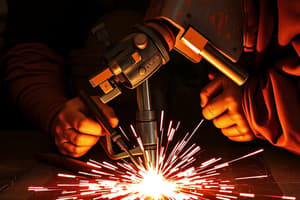Podcast
Questions and Answers
What is the primary purpose of welding symbols on a blueprint?
What is the primary purpose of welding symbols on a blueprint?
- To indicate the material to be used for the welding process
- To represent the type of weld, size, and configuration (correct)
- To indicate the type of welding process to be used
- To specify the welding sequence for the project
Why are tolerances important in welding blueprints?
Why are tolerances important in welding blueprints?
- To designate the material to be used for the welding project
- To ensure that the finished weld meets design specifications (correct)
- To dictate the specific welding process to be used
- To determine the weld size and configuration
What information is typically found within the drawing title block of a welding blueprint?
What information is typically found within the drawing title block of a welding blueprint?
- Materials list and procurement details for the welding project
- Project title, drawing number, date, scale, and drafter's name (correct)
- Welding procedure specifications for each weld
- Detailed instructions for assembling the components after welding
What is the primary purpose of welding procedure specifications (WPS)?
What is the primary purpose of welding procedure specifications (WPS)?
Which section of a welding blueprint would you find specific instructions regarding the welding process, parameters, and variables for a particular weld?
Which section of a welding blueprint would you find specific instructions regarding the welding process, parameters, and variables for a particular weld?
Which type of dimension specifies the precise size of a component?
Which type of dimension specifies the precise size of a component?
Aside from the welding process symbols, what other critical information about a weld can be conveyed through welding symbols?
Aside from the welding process symbols, what other critical information about a weld can be conveyed through welding symbols?
How do welding blueprints promote accuracy and consistency in welding projects?
How do welding blueprints promote accuracy and consistency in welding projects?
What is the significance of geometric tolerances in welding blueprints?
What is the significance of geometric tolerances in welding blueprints?
In context of welding blueprints, what is the significance of understanding tolerances?
In context of welding blueprints, what is the significance of understanding tolerances?
Which of these aids can be used to understand and interpret different conventions in blueprint reading?
Which of these aids can be used to understand and interpret different conventions in blueprint reading?
Which statement best describes the role of notes in a welding blueprint?
Which statement best describes the role of notes in a welding blueprint?
Why is accurate blueprint interpretation crucial for welding projects?
Why is accurate blueprint interpretation crucial for welding projects?
What is a key component of the blueprint review process, ensuring the accuracy and completeness of the drawings?
What is a key component of the blueprint review process, ensuring the accuracy and completeness of the drawings?
When reviewing blueprints, how can you ensure that the correct materials are being used for the welding project?
When reviewing blueprints, how can you ensure that the correct materials are being used for the welding project?
What is the primary outcome of meticulous blueprint review and adherence to specifications?
What is the primary outcome of meticulous blueprint review and adherence to specifications?
Flashcards
Welding Blueprints
Welding Blueprints
Technical drawings for fabricating and assembling components in welding.
Drawing Title Block
Drawing Title Block
Contains project information like title, number, date, scale, and drafter's name.
Part Identification
Part Identification
Specifies names and numbers of components to be welded.
Dimensions
Dimensions
Signup and view all the flashcards
Welding Symbols
Welding Symbols
Signup and view all the flashcards
Tolerances
Tolerances
Signup and view all the flashcards
Material Specifications
Material Specifications
Signup and view all the flashcards
Welding Procedure Specifications (WPS)
Welding Procedure Specifications (WPS)
Signup and view all the flashcards
Joint Symbols
Joint Symbols
Signup and view all the flashcards
Geometric Dimensioning and Tolerancing (GD&T)
Geometric Dimensioning and Tolerancing (GD&T)
Signup and view all the flashcards
Linear Dimensions
Linear Dimensions
Signup and view all the flashcards
Angular Dimensions
Angular Dimensions
Signup and view all the flashcards
Welding Parameters
Welding Parameters
Signup and view all the flashcards
Safety Precautions
Safety Precautions
Signup and view all the flashcards
Blueprint Reading Guides
Blueprint Reading Guides
Signup and view all the flashcards
Study Notes
Introduction to Welding Blueprints
- Welding blueprints are technical drawings that provide detailed instructions for fabricating and assembling components, including welding procedures.
- They are crucial for ensuring accuracy, consistency, and quality in welding projects.
- Blueprints contain a multitude of symbols, dimensions, and annotations, all of which must be correctly interpreted to avoid errors.
- Effective blueprint reading is essential for all welding professionals.
Essential Elements of Welding Blueprints
- Drawing Title Block: Contains critical project information such as the project title, drawing number, date, scale, and the name of the drafter.
- Part Identification: Specifies the name and number of each component being welded.
- Dimensions: Essential for accurate component sizing and fit. Provides precise measurements for various dimensions, including lengths, widths, heights, and angles. Detailed measurements are critically important for accurate welding.
- Welding Symbols: Represent the type of welding process (e.g., GMAW, GTAW, SMAW), weld joint type (e.g., butt, fillet), weld size and configuration. These are standardized symbols, aiding in the understanding of the required welding parameters.
- Tolerances: Indicate the allowable deviations from the specified dimensions. Understanding these tolerances is key to ensuring that the finished weld complies with design specifications.
- Material Specifications: Identifies the material to be used, including its chemical composition, specifications, and grade. This allows for correct material selection for the particular welding project.
- Welding Procedure Specifications (WPS): Provides detailed instructions regarding the type of welding process, parameters such as current, voltage, speed, and other variables required for the welding operation. These ensure a consistent level of quality across different welds.
- Notes: Offer supplementary information essential for the construction, clarification, or specific considerations from the design intent.
Understanding Welding Symbols
- Weld Symbols: Standardized symbols depict the type of weld, weld size, weld configuration, the start and ending points of the weld, weld details, and the joint type.
- Welding Process Symbols: Symbols for various welding processes (e.g., GMAW, GTAW, SMAW) specify the type of equipment required.
- Joint Symbols: Symbols for various joint types (e.g., butt, fillet, lap) indicate the shape of the joint needing welding.
- Geometric Dimensioning and Tolerancing (GD&T): Specifications regarding geometric characteristics of manufactured parts. These are increasingly prevalent in complex welding projects and add further detail to the blueprint regarding tolerances and expected dimensional deviations.
Deciphering Dimensions and Tolerances
- Linear Dimensions: Measurements indicated in millimeters or inches that ensure precise component size accuracy.
- Angular Dimensions: Measurements of angles, crucial for accurate alignment and positioning of components during welding.
- Geometric Tolerances: Allowable deviations from specified shapes and dimensions. These tolerances are crucial in managing dimensional variations in fabricated components.
- Dimensioning Strategies: Understanding the various conventions in blueprint dimensioning is essential for accurately interpreting blueprints.
Interpreting Welding Procedures
- Welding Procedure Specifications (WPS): Detailed documents that outline the specific welding procedures.
- Welding Parameters: These documents specify the welding parameters like current, voltage, speed, and travel angle that must be maintained during welding to ensure consistent results.
- Safety Precautions: Safe operating procedures and precautions for each welding process are usually outlined clearly, helping to mitigate potential hazards.
- Weld Quality Standards: Welding blueprints often include details concerning weld quality standards, which are imperative for maintaining safety and performance throughout the project duration.
Importance of Accuracy and Precision
- Accurate interpretation of blueprints is paramount in welding to ensure quality and functionality.
- Minor errors can lead to significant issues, including structural failure, decreased efficiency, and increased costs if not diligently interpreted.
- Adherence to specifications in blueprints is critical for successful welding projects.
Utilizing Blueprint Reading Aids
- Blueprint Reading Guides: Resource material dedicated to understanding and interpreting conventions in blueprint reading, and often includes examples to clarify different components of a blueprint.
- Online Resources: Many online resources give further support in deciphering welding blueprints.
- Software Applications: Specialized CAD (Computer-Aided Design) software can assist in the interpretation of advanced blueprints.
Blueprint Review Process
- Confirmation of Information: Review of the drawings for accuracy and completeness is crucial.
- Material Verification: Ensuring that the correct materials are used.
- Quality Control: Implementing procedures to ensure proper weld quality.
- Safety Checks: Checking that precautions adhere to safety guidelines.
Studying That Suits You
Use AI to generate personalized quizzes and flashcards to suit your learning preferences.




